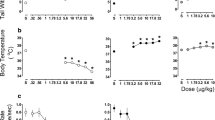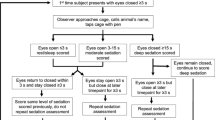Abstract
The kappa opioid, U50,488, was examined alone and in combination with the 5HT2 antagonists, ketanserin, pirenperone and LY 53857. Squirrel monkeys responded under a shock titration procedure in which shock intensity increased every 15 s from 0.01 to 2.0 mA in 30 steps. Five responses terminated the shock for 15 s, after which the shock resumed at the next lower intensity. The level at which the monkeys kept the shock 50% of the time (median shock level/MSL) was determined. U50,488 alone produced dose-dependent increases in median shock level whereas none of the 5-HT2 antagonists altered responding under this procedure. When ketanserin (0.032–5.6 mg/kg) was administered in combination with U50,488, very high doses of ketanserin (3.2–5.6 mg/kg) shifted the U50,488 dose-effect curve to the left. Neither pirenperone (0.032–10.0 µg/kg) nor LY53857 (0.01–0.32 mg/kg) altered the U50,488 dose-effect curve in any monkey. Taken together, these data do not support a role for the 5-HT2 system in kappa-induced antinociception in the primate.
Similar content being viewed by others
Abbreviations
- 5HT:
-
serotonin
- U50,488:
-
trans (+)-3,4-dichloro-N-methyl-N-[2-(1-pyrrolidinyl) cyclohexyl]-benzeneacetamide
- LY 53857:
-
[6 methyl-1-(1-methylethyl) ergoline-8-carboxylic acid 2-hydroxy-1-methyl-propylester (Z)-2-butenedioate (1: 1)1]
- MSL:
-
median shock level
References
Cohen ML, Colbert W, Wittenauer LA (1985) Receptor specificity of the 5HT2 receptor antagonist, LY 53857. Drug Dev Res 5:313–321
Colpaert FC, Niemeegers CJE, Janssen PAJ (1982) A drug discrimination analysis of lysergic acid diethylamide (LSD): in vivo agonist and antagonist effects of purported 5-hydroxytryptamine antagonists and of pirenperone, a LSD-antagonist. J Pharmacol Exp Ther 221:206–214
Craft RM, Dykstra LA (1990) Differential cross-tolerance to opioids in squirrel monkeys responding under a shock titration schedule. J Pharmacol Exp Ther 249:386–393
Craft RM, Dykstra LA (1992) Agonist and antagonist activity of kappa opioids in the squirrel monkey: I. Antinociception and urine output. J Pharmacol Exp Ther 260:327–333
Dykstra LA (1990) Butorphanol, levallorphan, nalbuphine and nalorphine as antagonists in the squirrel monkey. J Pharmacol Exp Ther 254:245–252
Dykstra LA, Massie CA (1988) Antagonism of the analgesic effects of mu and kappa opioid agonists in the squirrel monkey. J Pharmacol Exp Ther 246:813–821
Dykstra, LA, Gmerek DE, Winger G, Woods JH (1987) Kappa opioids in rhesus monkeys. I. Diuresis, sedation, analgesia and discriminative stimulus effects. J Pharmacol Exp Ther 242:413–420
Ho BY, Takemori AE (1989) Serotonergic involvement in the antinociceptive action of and the development of tolerance to the kappa-opioid receptor agonist, U-50,488H. J Pharmacol Exp Ther 250:508–514
Ho BY, Takemori AE (1990) Release by U-50,488H of [3H]serotonin from brain slices and spinal cord synaptosomes of U-50,488H-tolerant and nontolerant mice. J Pharmacol Exp Ther 254:8–12
Janssen PAJ (1983) 5-HT2 receptor blockade to study serotonin-induced pathology. TIPS 4:198–206
Kiefel JM, Paul D, Bodnar RJ (1989) Reduction in opioid and non-opioid forms of swim analgesia by 5-HT2 receptor antagonists. Brain Res 500:231–240
Leyson JE, Atwouters F, Kennis L, Laduron PM, Vandenderk J, Janssen PAJ (1981) Receptor binding profile of R41468, a novel antagonist at 5-HT2 receptors. Life Sci 28:1015–1022
Leyson JE, Niemegeers CJE, van Nueten JM, Laduron PM (1982)3H-ketanserin (R41468), a selective3H-ligand for serotonin 2 receptor binding sites. Mol Pharmacol 21:301–314
McKearney JW (1989) Apparent antinociceptive properties of piperazine-type serotonin agonists: trifluoromethylphenylpiperazine, chlorophenylpiperazine, and MK-212. Pharmacol Biochem Behav 32:657–660
McKearney JW (1990) Effects of serotonin agonists on operant behavior in the squirrel monkey: quipazine, MK-212, trifluoromethylphenylpiperazine, and chlorophenylpiperazine. Pharmacol Biochem Behav 35:181–185
Millan MJ (1989) Kappa-opioid receptor-mediated antinociception in the rat. I. Comparative actions of mu- and kappa-opioids against noxious thermal, pressure and electrical stimuli. J Pharmacol Exp Ther 251:334–341
Monroe PJ, Perschke SE, Crisp T, Smith DJ (1991) Evaluation of the interactions of serotonergic and adrenergic drugs with μ, δ and κ opioid binding sites. Neurosci Lett 133:229–232
Nakazawa T, Yamanishi Y, Kaneko T (1991) A comparative study of monoaminergic involvement in the antinociceptive action of E-2078, morphine and U50,488E. J Pharmacol Exp Ther 257:748–753
Passarelli F, Costa T (1989) Mu and delta receptors inhibit serotonin release in rat hippocampus. J Pharmacol Exp Ther 248:299–305
Paul D, Phillips AG (1986) Selective effects of pirenperone on analgesia produced by morphine or electrical stimulation at sites in the nucleus raphe magnus and periaqueductal gray. Psychopharmacology 88:172–176
Paul D, Mana MJ, Pfaus JG, Pinel JPJ (1989) Attenuation of morphine analgesia by the S2 antagonists, pirenperone and ketanserin. Pharmacol Biochem Behav 31:641–647
Porreca F, Mosberg HI, Hurst R, Hruby VJ and Burks TF (1984) Roles of mu, delta and kappa opioid receptors in spinal and supraspinal mediation of gastrointestinal transit effects and hotplate analgesia in the mouse. J Pharmacol Exp Ther 230:341–348
Porreca F, Mosberg HI, Omnaas JR, Burks TF, Cowan A (1987) Supraspinal and spinal potency of selective opioid agonists in the mouse writhing test. J Pharmacol Exp Ther 240:890–894
Schmauss C, Yaksh TL (1984) In vivo studies on spinal opiate receptor systems mediating antinociception. II. Pharmacological profiles suggesting a differential association of mu, delta and kappa receptors with visceral chemical and cutaneous thermal stimuli in the rat. J Pharmacol Exp Ther 228:1–12
Tang AH, Collins RJ (1985) Behavioral effects of a novel kappa opioid analgesic, U-50488, in rats and rhesus monkeys. Psychopharmacology 85:309–314
VanWijngaarden I, Tulp MTM, Soudijn W (1990) The concept of selectivity in 5-HT receptor research. Eur J Pharmacol 188:301–312
VonVoightlander PF, Lewis RA (1982) U-50,488, a selective kappa opioid agonist: comparison to other reputed kappa agonists. Prog Neuropsychopharmacol Biol Psychiatry 6:467–470
VonVoightlander PF, Lahti RA, Ludens JH (1983) U-50,488: A selective and structurally novel non-mu (kappa) opioid agonist. J Pharmacol Exp Ther 224:7–12
VonVoightlander, PF, Lewis RA, Neff GL (1984) Kappa opioid analgesia is dependent on serotonergic mechanisms. J Pharmacol Exp Ther 231:270–274
Ward SJ, Takemori AE (1983) Relative involvement of mu, kappa and delta receptor mechanisms in opiate-mediated antinociception in mice. J Pharmacol Exp Ther 224:525–530
Zimmerman DM, Leander JD, Reel JK, Hynes MD (1987) Use of β-funaltrexamine to determine mu opioid receptor involvement in the analgesic activity of various opioid ligands. J Pharmacol Exp Ther 241:374–378
Author information
Authors and Affiliations
Rights and permissions
About this article
Cite this article
Dykstra, L.A., Powell, K.R. & Lin, Y.P. Antinociceptive effects of the kappa opioid, U50,488: lack of modulation by 5-HT2 antagonists. Psychopharmacology 112, 116–120 (1993). https://doi.org/10.1007/BF02247371
Received:
Revised:
Issue Date:
DOI: https://doi.org/10.1007/BF02247371




